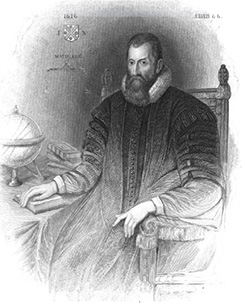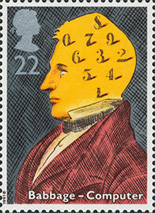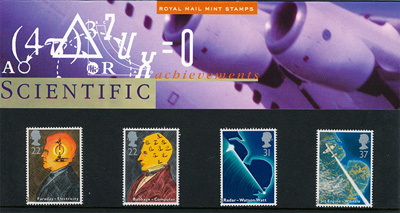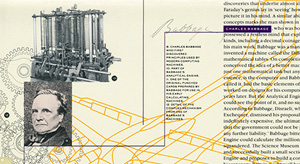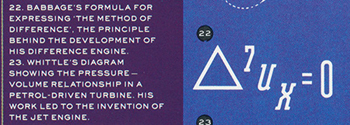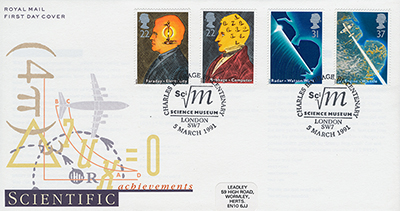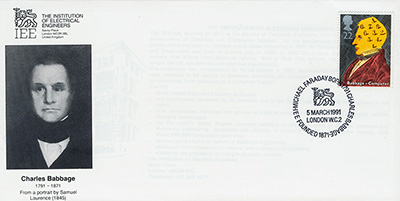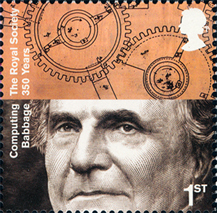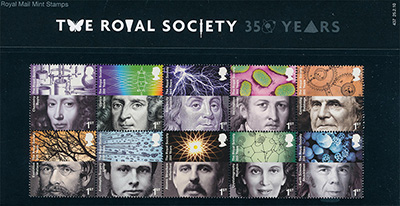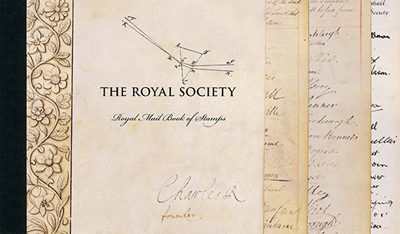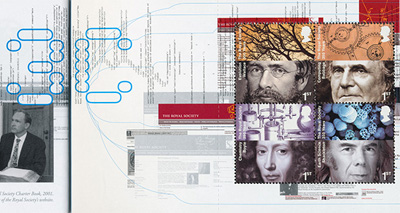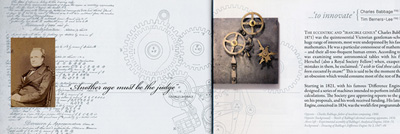On Napier's work on logarithms:
"The Invention was greedily embraced (and deservedly) by Learned Men." - 1685 by Dr. John Wallis, Savilian Professor of Geometry, University of Oxford. (Ref. 5.)
"The Canon Mirificus is the first British contribution to the mathematical sciences, and next to Newton's Principia it is the most important work in the history of the exact sciences that has been published in Great Britain, at all events until within the memory of living persons.
In whatever country the Canon Mirificus had been produced, it would have occupied the same commanding position, for it announced one of the greatest scientific discoveries ever made."
- 1915 by J. W. L. Glaisher, M.A., Sc.D, F.R.S, Fellow of Trinity College, Cambridge. (Ref. 7)
Introduction: In 1614 John Napier of
Scotland published his Mirifici Logarithmorum Canonis
Descriptio, a treatise on logarithms together
with tables related to the present natural logs. Although
not as well known as other groundbreaking books on mathematics
/ science, it certainly deserves to be so as the use of logarithms was far reaching in e.g. mathematics, astronomy,
navigation, finance. It was translated into English by Edward Wright in 1618 and published with the title A Description of the Admirable Tables of Logarithmes (9). The English mathematician Henry
Briggs in liaison with Napier constructed tables of logs
to the base ten which became the base most widely used. 2014
is the 400th anniversary of Napier's first publication and the
Royal
Society of Edinburgh has a webpage devoted to 'Napier
400' summarising the events being planned, which include a
free exhibition 'Power of Ten: Inventing Logarithms' by
National Museums Scotland and some meetings.
Nowadays with calculators or smartphone apps an arms length away providing answers to complex calculations in sub-seconds to umpteen decimal places, its easy to forget how valuable logarithms became when Napier's work was published—as Wallis eloquently summarised in header quote—they were 'greedily embraced'. The potential of
logarithms to transform complex multiplication and
division to much simpler and less error prone operations using
addition and subtraction was quickly recognised, both in tabular form and as logarithmically ruled scales in the form of the Gunter's scale and slide rules. Other
workers (8) who are known to have contributed to logarithms and/or
exponents include Archimedes (4) and Michael Stifel. Jost Bürgi
independently developed his own
method for creating logarithmic tables but published later in
1620. Napier's rods (or bones) are a manual calculating device which Napier devised.
As a collector of slide rules and
with a casual interest in the history of mathematical tables, this article is my own modest 'raising a glass' to Napier on the 400th anniversary by sharing a gallery of collectables
with a wider logarithmic theme—as
to date only two have been identified that are directly associated with John
Napier. In 2006 Werner Rudowski
shared a splendid illustrated article covering the theme
of 'Logarithms, Slide Rules and Abaci on Stamps, Coins and
Banknotes' (1). I don't wish to overlap his presentation so I
concentrate on collectables either published since 2006 or
on how known items have been variously presented. I would be
interested to learn of other items.
John Napier and other mathematicians:
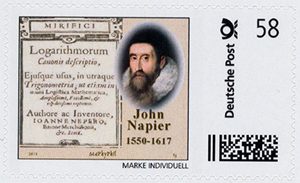
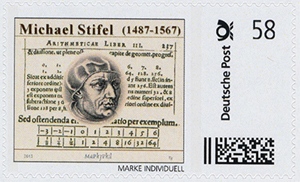
Above: In 2012 a set of 21 stamps depicting
mathematicians in the Deutsche Post 'Marke Individuell'
series did feature a portrait of Napier, the only stamp to
my knowledge published to date that does. The title page of
his 'Descriptio' is also incorporated (left above).
Fortuitously the series also included the German monk and
mathematician Michael Stifel whose work is cited by
historians in the history of logarithms and exponents. The
stamp shows a page from his 'Arithmetica Integra' published
in 1544 (see Wikipedia
entry).
These 'Marke Individuell' series
are end user designs submitted to Deutsche Post for approval
but are valid post. The series looks professionally designed
and do wonder who instigated them, perhaps an institution in
Germany. The individual stamps and full set were previously
available on delcampe.net but has been replaced at time of
writing by an extensive new set of mathematicians and their work.
Note added Jan. 19th 2014. Thank you to Werner Rudowski who remarks: "One can order a block of 20 stamps, each 60 cents for a total of €39.85, i.e. each one would cost about €2."
Note added October 25th 2015. The above stamps were designed and issued by Dieter Egelriede who sells them on delcampe.net under his delcampe ID 'Pzbrig2'. With thanks to Dieter for a personal communication.
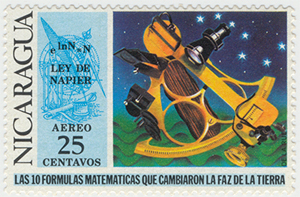
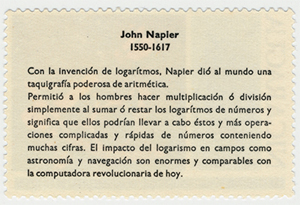
Nicaragua, 1971, 'Las 10
formulas matematicas que cambiaron la faz de la
tierra' ('10 mathematical formulas that changed
the face of the earth' - Google Translation).The sea, stars and sextant
emphasise the profound impact that logarithms had on
navigation / astronomy. Illustrated by Werner Rudowski
(1), to date this and the German stamp above, are
possibly the only two known devoted to John Napier.
A short
biography is presented on the stamp's reverse. A neat idea that
could be more widely adopted to describe the theme of
a stamp.
Charles Babbage and philately: The
majority of logarithmic themed collectables found to date
present Charles Babbage and his work. Babbage needs no
introduction and is well known for his ambition to build
mechanical engines using the method of differences to both
calculate and print out error free and accurate tables
including logarithms. His difference engine designs were
never completed but the Science Museum UK successfully built
his Difference Engine No. 2 in time for the bicentennial of
his birth on December 26th 2001 (6). The printer was later successfully built and added.
Both were shown to work very well. (See below for notes on his
Analytical Engine.)
Great Britain, 1991, 'Scientific
Achievements'. A stamp showing a profile of a youthful
Babbage and a stylised illustration of the method of
differences formed part of the Royal Mail 'Scientific
Achievements' series. Werner Rudowski illustrated this stamp
in ref. 1 remarked on above, but also featured in his
fascinating article 'Images of Charles Babbage' discussing and
illustrating portraits / photos of Babbage that are known (3). The latter
article is useful in identifying which portrait was used where
featured in stamp / first day cover designs. Below are
additional presented examples of how the Babbage stamp in this
series was featured.
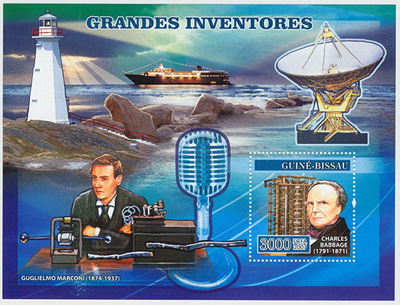

Left above:
Republic of Guinea-Bissau, 2007, 'Grandes Inventions'.
An attractive stamp with an older portrait of Babbage
and engine.
Right
above: Gabon Republic, 2001, invention of calculator.
A cleverly thought out design incorporating part
of a Babbage engine in background and showing the
transition from mechanical to thermionic valve to
modern integrated circuit calculator designs. Correction Sept. 28th 2018. A discrete transistor is shown not a valve! The progression shown in the design is thus from Babbage's to later mechanical calculators, discrete transistors then to modern calculators which typically use single chip microprocessors for calculation.
Other Babbage themed collectables. The Isle of Man in 1999 issued an attractive FDC featuring a design with Babbage portrait on the envelope and an Isle of Man 1995 one crown coin embedded 'Inventions of the Modern World'. The coin has a stylised design of his analytical engine. This fomed part of the 'Millennium Coin Cover Series'. This is available from a variety of stamp/coin dealers.
Some test currency notes printed by De La Rue also featured intricate designs showing a portrait of Babbage and aspects of his technical drawings. delcampe.net sometimes sell these.
Babbage and trains: I'm not a train buff
but while 'Googling' for Babbage related items I stumbled on
an attractive detailed working model of a British Rail
Class 60 diesel locomotive. Wikipedia informs us that the Class 60
was first in service in 1989 and designed for 'heavy freight'
duties such as aggregate, coal and petroleum. The
engine numbered 60054 was given the 'Charles
Babbage' nameplate. Wiki' notes that examples in
this class for coal / petroleum use were named after
those who had contributed to science or engineering.
For the collector of all things logarithmic, if
ever an excuse was needed to persuade our families that a
train set was justified—here's a good reason! Working model
locomotives with this detail are quite expensive (typically
£70+ on eBay UK), so I'm grateful to a dealer for
a photograph of this model.

Product details as
stated by Hatton's Model Railways: "Manufacturer [of
model]: Graham Farish. Scale: N Gauge. Product
Code: 371-354.
Product Title: Class 60 diesel 60054 'Charles
Babbage' in BR Railfreight Petroleum sector livery."
Image © Hatton's
Model Railways, Liverpool, UK and used with their
kind permission.

Wikipedia fortuitously illustrate their Class 60 entry with the real life
'Charles Babbage' engine at high resolution and shared here
under the 'GNU Free documentation License' (image
cropped and resized) with thanks to the originator
'Janderk1968'
Slide rules and philately: Slide rules and their scales use the principles of logarithms to provide powerful and versatile tools for a range of calculations. The first slide rules were developed only a few years after Napier's publications in 1622 by William
Oughtred and others. To my knowledge
there are at least ten stamps that show a recognisable slide
rule in its design although some examples are admittedly in
the 'blink and you'd miss it' category!
Below are all the stamps either previously
reported or have come across myself to date that show a slide
rule (there
are no doubt more), plus a selection of first day
covers that feature them on the envelope design. Eking out
some examples were a direct result of seeing what photographs
depicting a scientist with slide rule had been used on a
stamp. The Crick and Watson, Whittle, Fermi and
Segrè examples below were found this way with the help of
Mike Konshak's splendid gallery of 'Historical Photos of People with
Slide Rules and Related Ephemera' on his International
Slide Rule Museum website.
A Crick and Watson photo with DNA
model: One of the iconic photos that
presents Crick and Watson in front of their DNA model
shows a slide rule being used as the pointer by Francis Crick.
A fascinating and poignant article in the UK Slide Rule
Gazette (2) described and illustrated the story behind
this series of photographs (and featured on the Gazette's front
cover). Some stamps and other philately items have used this
photograph as shown below.
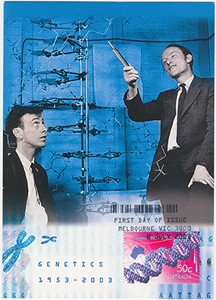
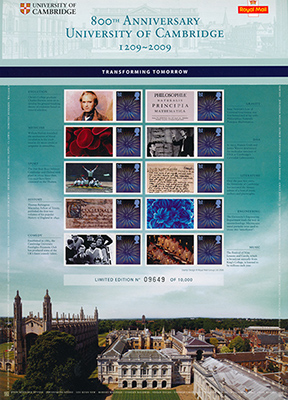

Left above:
Australia 2003. Maximum card. Collecting maximum cards is
a formal branch of philately called maximaphily. They are
cards with the stamp placed on the front of a commercial
postcard where the subject of the postcard, stamp and
postmark show a high degree of concordance. See 'Microscopy
themed maximaphily',
Micscape February 2013.
Middle above and detail to the right:
Great Britain 2009. Cambridge University 800th
anniversary, commemorative sheet CS6. The unlabelled stamp
attached to the postage stamp showing Crick and Watson is
called a 'se-tenant label' and a form regarded to be
a legitimate thematic (with thanks to members of the
Stamp Community Forum for clarifying
its terminology). © Stamp Design Royal Mail Group Ltd (2009).

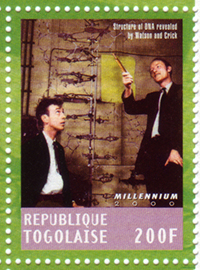
Above: Togo
(République Togolaise) in the 1990s published a
series of Millennium sheets celebrating aspects of
different decades from the 20th century. This sheet for
the 1950s uses the same iconic photo of Crick and Watson
(top right of sheet, detail on right).
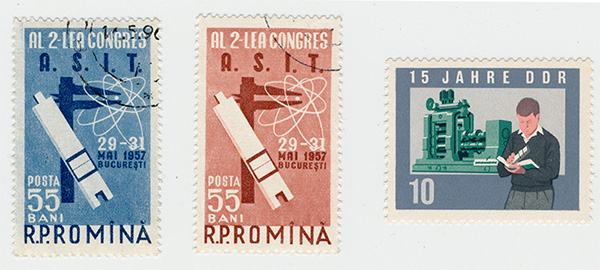
Left and middle
above: Romania, 1957, 'AL2-LEA Congress' depicting a
stylised slide rule. These were illustrated by Werner
Rudowski in his 2006 article (1).
Right above:
German Democratic Republic, 1962, mechanical engineering?
A 'blink and you'd miss it example' but believe a
slide rule is shown.

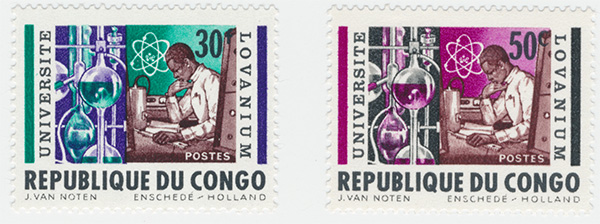
Republic of the
Congo, 1964, University Lovanium 20th anniversary. The far
left stamp forms part of an adhesive sheet of unperforated
stamps, the middle and right are discrete perforated
stamps. Again the slide rule barely features but
collectors of such a very narrow theme can't be too fussy!
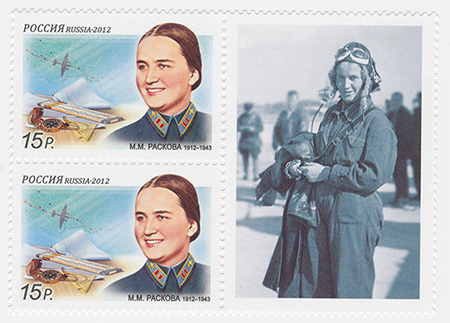
Russia 2012,
Marina M Raskova, female pilot and navigator, celebrating
100 yrs since her birth. See Wikipedia entry for a biography. An
attractive design with sufficient detail for knowledgeable
collectors to recognise as a real slide rule model and
thought to be 'an early NL-type' (with thanks to Ronald
van Riet, see discussion on Yahoo International Slide Rule group
).
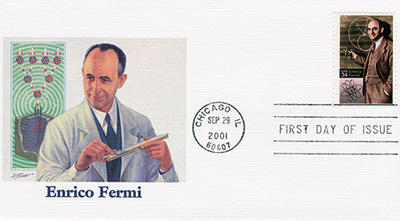
USA First day
cover 2001. This is again based on a photograph of Fermi
and both the photograph and this FDC are shown in the
International Slide Rule Museum gallery. The
back of the envelope states the image source: 'Original painting for
the First Day Cover by Gherman Komlev. Authorised by Ms. Rachel
Fermi.' ©
Fleetwood.
Comments to the
author David Walker
are welcomed.
Acknowledgments:
Thank you to the Director of Hatton's Model Railways for
permission to use the model train image.
Thank you to Werner Rudowski for his article in reference 1
which inspired me to start my own collection and to seek
other examples since it was published. Also for his useful suggestion for the article.
Thank you to Mike Konshak for his International Slide
Rule Museum website. The site's extensive photographic
gallery showing scientists using slide rules provided leads
to seek out a number of stamps showing slide rules.
A number of the free access links in the references
below above to specialist literature are hosted on Rod Lovett's website where he meticulously maintains a large database of specialist literature in collaboration with the appropriate journal / magazine publishers.
Images of Royal Mail stamps and related material used under their guidelines on this not-for-profit educational website.
Note on image
use: The copyright of all images where not specified if not known,
remains with the originator(s). Both these and those where the
owner is not specified have been used under the US
'Fair Use' of copyrighted material guidelines for use in an educational and
not-for-profit review context as Micscape is hosted in the
USA. Image size is modest to allow only screen use.
Images showing extensive text are at a size / crop to show
the design elements only. 'Right
clicking' to save an
image offline
has
also been disabled.
Note added February 22nd 2015. Since writing this article, the server has moved from the USA to the UK. 'Citing the US 'Fair Use' policy for third party image use (widely used e.g. by Wikipedia) is thus no longer valid. The article has been retained as an educational resource on this
not-for-profit website. If a copyright holder objects, please contact the author above and we will be pleased to remove the image or change/add any image credit. Thank you.
Note on
sourcing items: My favourite source of thematic stamps
and other collectibles is delcampe.net where the prices are
often cheaper than eBay or dealers with their own websites.
Notes on
descriptions: I have not included stamp catalogue
numbers (e.g. Stanley Gibbons, Michel, Scott) as I'm
interested in the topics depicted on stamps rather than the
associated philately and don't have access to the
catalogues. Most dealers specialising in thematics offer
searches on a given theme.
References
1) Werner
H Rudowski, 'Logarithms, Slide Rules and Abaci on Stamps,
Coins and Banknotes', UK Slide Rule Circle 'Gazette', 2006,
August, Issue 7, pp. 61-65. (Available to read on Rod
Lovett's website.)
2) Colin
Barnes and Rod Lovett, 'The Making of an Iconic Image', UK
Slide Rule Circle 'Gazette', 2012, August, Issue 13, pp. 1-6.
3) Werner H Rudowski, 'Images
of Charles Babbage', UK Slide Rule Circle 'Gazette', 2006,
August, Issue 7, pp. 7-14. (Available to read on Rod
Lovett's website.)
4) Peter
Holland, 'Archimedes - His Approach Towards Logarithms',
Journal of the Oughtred Society, 2005, Volume 14, No. 2, pp.
17-21. (Available to read on Rod
Lovett's website.)
5) John Wallis, 'Treatise of Algebra', Chapter 12, page 55 'Of Logarithms and their Use', 1685 and chapter reprinted in 'Sherwin's Tables', 1705/6 and later editions. (Link is to a hi-res facsimile on the 'ECHO Cultural Heritage Online' website.)
6) Doron Swade, 'The Cogwheel brain', 2000, Abacus Little Brown and Company.
7) JWL Glaisher in 'Logarithms and Computation, Napier Tercentenary Memorial Volume, Ed. C G Knott, Longmans, 1915. (Link is to www.archive.org copy.)
8) Florian Cajori, 'Algebra in Napier's day and alleged prior inventions of logarithms', ibid, pp.93-109.
9) Edward Wright, 'A Description of the Admirable Table of Logarithmes', 1616 and later editions. (Available in modern fascimile copies from bookshops. The Renascent Books (UK) edition is excellent, 2013. Available from Amazon UK in paperback.)
10. Ioanne Nepero [John Napier], 'Mirifici Logarithmorum Canonis
Descriptio', 1620. (The Google Books link is to the 1620 edition with additional contributions by Henry Briggs.).
Additional selection of resources (Not linked to in the text.)
- Logarithms: The Early History of a Familiar Function by K M Clark and C Montelle, in the 'Convergence' Series published by the Mathematical Association of America. A superb and very accessible set of illustrated articles online presenting clear explanations of logarithms and their development by Napier and Bürgi, which was very different from
our modern concept of logarithms.
- William Rae Macdonald', 'The construction of the wonderful canon of logarithms. Translated from
Latin into English with notes and a catalogue of the various editions of
Napier's works', William Blackwood and Sons, 1889. (Link is to www.archive.org copy. The original Latin 'Construction' was written before the 'Description' but published after John Napier's death by his son Robert in 1619.)
- Robin J Wilson, 'Stamping Through Mathematics', Springer,
2001, 126pp. A delightful extensively illustrated book.
- Lynne Gladstone-Millar, 'John Napier. Logarithm John', National Museums Scotland, 'reformatted and reprinted' 2013, 64pp. Copiously illustrated in colour and black and white, a very accessible and rounded history of his life, his work on logarithms and their impact to this day. Excellent value at <£5 new from Amazon UK Marketplace.
- Werner H Rudowski, 'Images
of John Napier, Baron of Merchiston', UK Slide Rule Circle 'Gazette', 2005,
August, Issue 6, pp. 77-85 and later update in 2006. (Available to read on Rod
Lovett's website and ... An Update in Issue 7, 2006, pp.45-46.)
Related 'Micscape Lite' articles
'A selection of portable calculating aid designs spanning over 2000 years', Micscape August 2013.
'The Appeal of Slide Rules - For Use and as Collectables', Micscape December
2012.
'Some typical slide rules under the low power microscope', Micscape December 2013. (PDF file)
First published January 13th 2014, revised January 19th, 2014.
Revised October 20th 2015, corrected date of Stifel's 'Arithmetica Integra' to 1544.
Revised October 25th 2015. German stamps showing Napier and Stifel credit added as now known to be Dieter Egelriede.
Revised September 28th 2018, corrected caption to the Gabon Republic 2001 stamp.
